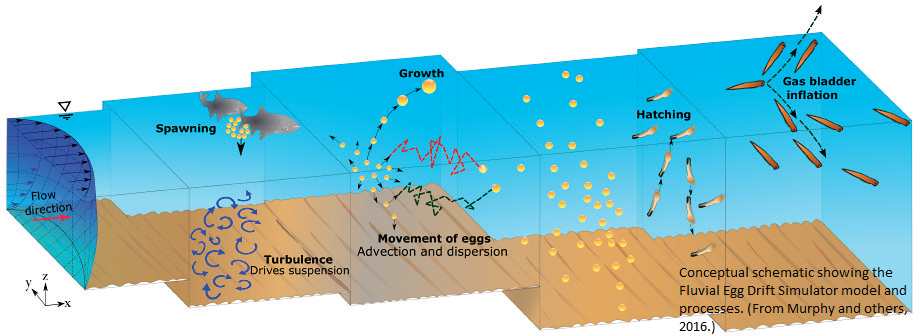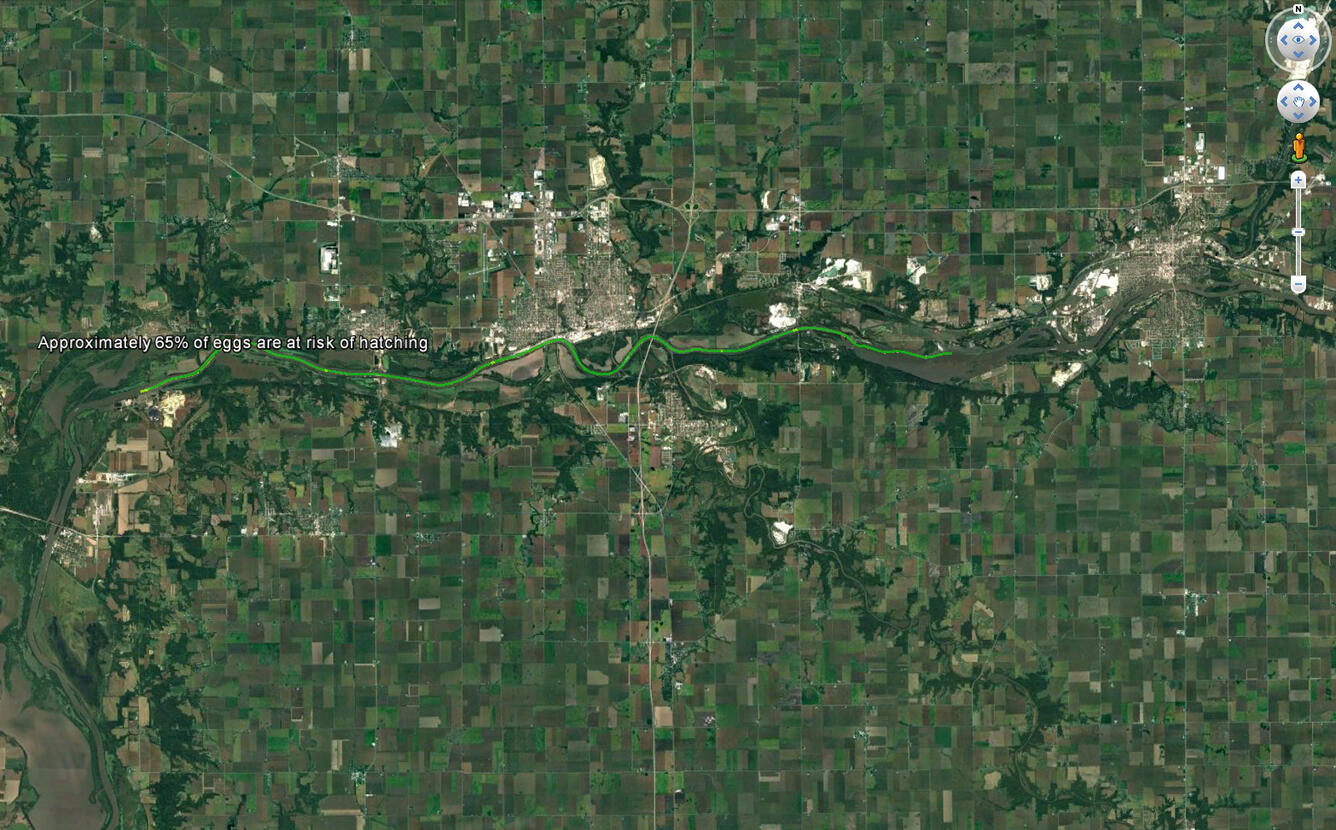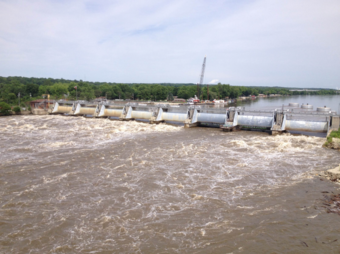Invasive Carp Risk Assessment and Life History
Increased threat of Invasive carp entering the Great Lakes and spreading to other basins such as the Upper Mississippi River and Ohio River basins, has led to increased prevention and control efforts since 2010. USGS Invasive carp biology and life history research has led to the development of models, tools and strategies to better understand the risk of Invasive carp establishment and survival.
USGS scientists, in collaboration with partners, are conducting risk assessments and life history research to enhance the ability of agencies to manage Invasive carp to minimize their influence and spread. Risk assessments are conducted to estimate the likelihood a species may invade, spread, or cause economic or ecological damage; to identify ecosystems or habitats most likely to be invaded; and to estimate other risks associated with species’ invasions. USGS risk assessment and life history science projects are described below. Check out the Invasive Carp Action Plan at asiancarp.us for more details on this work and other Invasive carp activities

Fluvial Egg Drift Simulator (FluEgg) - FluEgg is a numerical model that can be used to assess Invasive carp (Silver, Bighead, and Grass carp) reproduction risk in rivers. This tool can be used to evaluate the influence of flow velocity, shear velocity and turbulent diffusion on the transport and dispersal patterns of Invasive carps eggs. The simulations show how Invasive carp drifting eggs are kept in suspension and transported by hydrodynamic characteristics of the flow and how the eggs’ physical properties influence their drifting behavior and the larval development up to gas bladder inflation stage when carp must leave the drift to find nursery habitat.
Spawning Locations Using EggDrift Simulator - Developmental rate and fate and transport of eggs and larvae is a key parameter to be incorporated in models that determine where Invasive carps are capable of spawning, and also, when coupled with field collections of drifting eggs and larvae, can be used to determine spawning locations or where the larvae will leave the drift and move to nursery locations. These locations are required to inform control efforts based on spawning disruption or destruction of the carp in their nurseries.
These data were used to model the spawning locations of Invasive carps in the Missouri River and in the development of the more advanced FluEgg model, which can be used to determine whether a river is at risk for reproduction by Invasive carps. A temperature model was developed that describes the relationship between developmental rate and temperature for each developmental stage. Knowledge of where and how Invasive carp larvae arrive in nursery areas is required to focus efforts on destruction of the larvae and juveniles. Furthermore, knowledge of depth selection and swimming speed are needed to enhance early detection efforts based on egg and larvae detection.

Decision Support Tool for Invasive Carp Spawning Events - Advances in technology, increased data accessibility, and improved models have increased our ability to better understand terrestrial and aquatic ecosystems. Leveraging this new capacity to visualize and understand natural events gives science a much larger impact on management decisions. This project capitalizes on advancements in software, data and technology in order to understand and visualize Invasive Carp spawning events along the Illinois River. Progress has been made in understanding Invasive carp spawning events, particularly related to egg and larval drift characteristics. It is now necessary to build on this information with the goal of informing sampling efforts and management decisions. Using existing flow data, we aim to develop a Decision Support Tool (DST) that utilizes HEC-RAS (USACE) and FluEgg models to determine where egg plumes would disperse over time. Such a model would output maps and estimated coordinates of not just one, but multiple spawning events with user specified flow parameters over the extent of the Illinois River (or specified area), displaying a composite plume. This DST will be extremely useful in advising barge traffic of times and locations where entrainment of eggs and larvae could occur, thus informing control efforts. The data will also be formatted for consumption by future DSTs to further aid in Invasive carp management.
Hydraulic and Water-Quality Influences on Invasive Carps Movement, Spawning, and Recruitment - The distribution of the Invasive carp population within the pools of the Illinois River has been monitored and habitats favorable for Invasive carp have been identified. Sharp contrasts in habitat, flow conditions, water quality, and food supply between the Marseilles and Dresden Island Pools and the Chicago Area Waterway System may be acting as controlling factors to the stalled upstream movement. In addition to the Illinois River, other rivers provide an opportunity to examine factors that influence Invasive carp movement, spawning, and recruitment. An objective of this project is to determine the controlling factor(s), with the possibility that one or more of these factor(s) could be used to prevent future expansion into additional rivers or to reduce Invasive carp populations.

High-Head Dam Barrier Characteristics - High-head dams in the upper Illinois and Des Plaines River system might act to limit the expansion of bigheaded carp by restricting their movements upstream and thus aid in preventing them from establishing in the Great Lakes. High-head locks and dams in the system include Starved Rock, Marseilles, Dresden Island, Brandon Roads and Lockport. To assess the barrier characteristics of these dams, USGS obtained historical hydrologic data (31 years) from the U.S. Army Corps of Engineers to determine the amount of time each dam spends at open-river. Open-river is the hydrologic condition defined by when dam gates are completely (or nearly so) lifted from water to allow maximum water passage during high discharge events. Fish passage at these types of navigation dams is thought to be generally restricted to periods of open river or near open river. USGS in collaboration with Southern Illinois University will also determine the hydrologic condition at these dams during bigheaded carp upstream passage events that occurred between 2012 and 2016.

Influence of Barges on the Upstream Movement of Invasive Carp - The purpose of this research, conducted jointly by the U.S. Fish and Wildlife Service, U.S. Army Corps of Engineers, and U.S. Geological Survey, was to determine the influence of commercial tows on the movement of juvenile fish, including the efficacy of the Electric Dispersal Barrier System (EDBS) in the Chicago Sanitary and Ship Canal (CSSC). In 2016, there was a large-scale field study to examine potential vulnerabilities in the EDBS during transit of tows through the barrier system. This study included sonar-based observations of wild fish while a tow consisting of a tug vessel and six fully-loaded barges traversed the EDBS under typical dry weather flows. Additionally, as the tow passed through the EDBS, its effect on flow velocity and voltage gradient was measured. Previous work had identified the potential for juvenile fish to be entrained in the rake-to-box junction between barges and then retained and transported in excess of 15 km and through locks.
Small fish were observed passing upstream through the EDBS concurrent with passage of tows moving downstream. The upstream passage of fish was linked to decreases in voltage gradients and upstream return currents induced by downstream tow transits. All fish observed passing through the EDBS during the trials are believed to be native species (no evidence of Invasive carp). USGS will continue to partner with U.S. Fish and Wildlife Service and U.S. Army Corps of Engineers to research mitigation approaches to the passage of small fish at the EDBS. A field study of mitigation techniques took place in 2017 and those data are being analyzed.
Below are publications associated with this project.
Simulation of hypothetical Asian carp egg and larvae development and transport in the Lockport, Brandon Road, Dresden Island, and Marseilles Pools of the Illinois Waterway by use of the Fluvial Egg Drift Simulator (FluEgg) model
Application of the FluEgg model to predict transport of Asian carp eggs in the Saint Joseph River (Great Lakes tributary)
Development of a Fluvial Egg Drift Simulator to evaluate the transport and dispersion of Asian carp eggs in rivers
Below are partners associated with this project.
Increased threat of Invasive carp entering the Great Lakes and spreading to other basins such as the Upper Mississippi River and Ohio River basins, has led to increased prevention and control efforts since 2010. USGS Invasive carp biology and life history research has led to the development of models, tools and strategies to better understand the risk of Invasive carp establishment and survival.
USGS scientists, in collaboration with partners, are conducting risk assessments and life history research to enhance the ability of agencies to manage Invasive carp to minimize their influence and spread. Risk assessments are conducted to estimate the likelihood a species may invade, spread, or cause economic or ecological damage; to identify ecosystems or habitats most likely to be invaded; and to estimate other risks associated with species’ invasions. USGS risk assessment and life history science projects are described below. Check out the Invasive Carp Action Plan at asiancarp.us for more details on this work and other Invasive carp activities

Fluvial Egg Drift Simulator (FluEgg) - FluEgg is a numerical model that can be used to assess Invasive carp (Silver, Bighead, and Grass carp) reproduction risk in rivers. This tool can be used to evaluate the influence of flow velocity, shear velocity and turbulent diffusion on the transport and dispersal patterns of Invasive carps eggs. The simulations show how Invasive carp drifting eggs are kept in suspension and transported by hydrodynamic characteristics of the flow and how the eggs’ physical properties influence their drifting behavior and the larval development up to gas bladder inflation stage when carp must leave the drift to find nursery habitat.
Spawning Locations Using EggDrift Simulator - Developmental rate and fate and transport of eggs and larvae is a key parameter to be incorporated in models that determine where Invasive carps are capable of spawning, and also, when coupled with field collections of drifting eggs and larvae, can be used to determine spawning locations or where the larvae will leave the drift and move to nursery locations. These locations are required to inform control efforts based on spawning disruption or destruction of the carp in their nurseries.
These data were used to model the spawning locations of Invasive carps in the Missouri River and in the development of the more advanced FluEgg model, which can be used to determine whether a river is at risk for reproduction by Invasive carps. A temperature model was developed that describes the relationship between developmental rate and temperature for each developmental stage. Knowledge of where and how Invasive carp larvae arrive in nursery areas is required to focus efforts on destruction of the larvae and juveniles. Furthermore, knowledge of depth selection and swimming speed are needed to enhance early detection efforts based on egg and larvae detection.

Decision Support Tool for Invasive Carp Spawning Events - Advances in technology, increased data accessibility, and improved models have increased our ability to better understand terrestrial and aquatic ecosystems. Leveraging this new capacity to visualize and understand natural events gives science a much larger impact on management decisions. This project capitalizes on advancements in software, data and technology in order to understand and visualize Invasive Carp spawning events along the Illinois River. Progress has been made in understanding Invasive carp spawning events, particularly related to egg and larval drift characteristics. It is now necessary to build on this information with the goal of informing sampling efforts and management decisions. Using existing flow data, we aim to develop a Decision Support Tool (DST) that utilizes HEC-RAS (USACE) and FluEgg models to determine where egg plumes would disperse over time. Such a model would output maps and estimated coordinates of not just one, but multiple spawning events with user specified flow parameters over the extent of the Illinois River (or specified area), displaying a composite plume. This DST will be extremely useful in advising barge traffic of times and locations where entrainment of eggs and larvae could occur, thus informing control efforts. The data will also be formatted for consumption by future DSTs to further aid in Invasive carp management.
Hydraulic and Water-Quality Influences on Invasive Carps Movement, Spawning, and Recruitment - The distribution of the Invasive carp population within the pools of the Illinois River has been monitored and habitats favorable for Invasive carp have been identified. Sharp contrasts in habitat, flow conditions, water quality, and food supply between the Marseilles and Dresden Island Pools and the Chicago Area Waterway System may be acting as controlling factors to the stalled upstream movement. In addition to the Illinois River, other rivers provide an opportunity to examine factors that influence Invasive carp movement, spawning, and recruitment. An objective of this project is to determine the controlling factor(s), with the possibility that one or more of these factor(s) could be used to prevent future expansion into additional rivers or to reduce Invasive carp populations.

High-Head Dam Barrier Characteristics - High-head dams in the upper Illinois and Des Plaines River system might act to limit the expansion of bigheaded carp by restricting their movements upstream and thus aid in preventing them from establishing in the Great Lakes. High-head locks and dams in the system include Starved Rock, Marseilles, Dresden Island, Brandon Roads and Lockport. To assess the barrier characteristics of these dams, USGS obtained historical hydrologic data (31 years) from the U.S. Army Corps of Engineers to determine the amount of time each dam spends at open-river. Open-river is the hydrologic condition defined by when dam gates are completely (or nearly so) lifted from water to allow maximum water passage during high discharge events. Fish passage at these types of navigation dams is thought to be generally restricted to periods of open river or near open river. USGS in collaboration with Southern Illinois University will also determine the hydrologic condition at these dams during bigheaded carp upstream passage events that occurred between 2012 and 2016.

Influence of Barges on the Upstream Movement of Invasive Carp - The purpose of this research, conducted jointly by the U.S. Fish and Wildlife Service, U.S. Army Corps of Engineers, and U.S. Geological Survey, was to determine the influence of commercial tows on the movement of juvenile fish, including the efficacy of the Electric Dispersal Barrier System (EDBS) in the Chicago Sanitary and Ship Canal (CSSC). In 2016, there was a large-scale field study to examine potential vulnerabilities in the EDBS during transit of tows through the barrier system. This study included sonar-based observations of wild fish while a tow consisting of a tug vessel and six fully-loaded barges traversed the EDBS under typical dry weather flows. Additionally, as the tow passed through the EDBS, its effect on flow velocity and voltage gradient was measured. Previous work had identified the potential for juvenile fish to be entrained in the rake-to-box junction between barges and then retained and transported in excess of 15 km and through locks.
Small fish were observed passing upstream through the EDBS concurrent with passage of tows moving downstream. The upstream passage of fish was linked to decreases in voltage gradients and upstream return currents induced by downstream tow transits. All fish observed passing through the EDBS during the trials are believed to be native species (no evidence of Invasive carp). USGS will continue to partner with U.S. Fish and Wildlife Service and U.S. Army Corps of Engineers to research mitigation approaches to the passage of small fish at the EDBS. A field study of mitigation techniques took place in 2017 and those data are being analyzed.
Below are publications associated with this project.
Simulation of hypothetical Asian carp egg and larvae development and transport in the Lockport, Brandon Road, Dresden Island, and Marseilles Pools of the Illinois Waterway by use of the Fluvial Egg Drift Simulator (FluEgg) model
Application of the FluEgg model to predict transport of Asian carp eggs in the Saint Joseph River (Great Lakes tributary)
Development of a Fluvial Egg Drift Simulator to evaluate the transport and dispersion of Asian carp eggs in rivers
Below are partners associated with this project.

